Home Intravenous (IV) Antibiotic Teaching Pack for Children / Parents / Carers of Children with Cystic Fibrosis (CF)
Please note, this page is printable by selecting the normal print options on your computer.
Personal details
Patient’s Name:
Address:
Date of birth:
Hospital number:
Name of consultant:
Allergies:
Weight:
Date of last competency check:
Please use the following telephone numbers if you have any concerns about giving IV’s or about your child’s condition.
Terri James CF (Advanced nurse practitioner) 01908 996574 bleep 1171
Available Tuesday/Wednesday/Thursday 08.30-16.30
Lorna Bass (Respiratory nurse specialist) 01908 996574 bleep 1171
Available Monday/Tuesday/Friday 09.00-17.00
Secretary to Dr Oommen (Consultant) 01908 996502
Available Monday-Friday 08.30-15.00
Ward 4 (PAU) 01908 996368
Available 24 hours
Children’s Community Nurses 01908 996518
For staff only: If the date of the last competency check is more than a year ago, please reassess the parent/carer using competency checklist
Introduction
To give IV antibiotics requires skill, strict hygiene and time. There are many elements to consider including side effects of antibiotics and what to do in an emergency. The safety of your child is
paramount so you will be taught individually and given support by the ward staff and your CF/Respiratory nurse. Once you have learned how to administer the IV antibiotics you will be assessed by trained nurses to ensure you are safe, confident and competent to carry out this procedure by yourself at home. The training may take up to 5 days to complete and involves working through this package to ensure you learn how to give the antibiotics safely.
Prior to discharge home you must sign to say you are willing to take responsibility for administering the IV antibiotics at home to your child.
Aim of this teaching pack
You will be expected to:
1. Learn how to give IV antibiotics safely and competently via an IV Line/PortaCath
2. Name the medicines being used and the reasons for administering them.
3. State dosages and timings of medicines to be given.
4. Name possible side effects of medicines.
5. State the possible complications that may be encountered when giving IV antibiotics, including anaphylaxis and what to do if any of these complications occur.
6. Keep a record of the medication administered on the drug/medication sheet.
7. How to store the medications correctly.
Home IV teaching protocol
1. Prior to completing the home IV teaching package a home assessment will be completed by the CF nurse/respiratory nurse to ensure your home is a safe place in which to administer the IV’s
2. The home IV antibiotic training will be done during a ward admission. You will observe a nurse preparing and giving the IV antibiotics using an aseptic non touch technique (ANTT) you will then be observed preparing and giving the antibiotics yourself.
3. This training pack must be completed and your accessor must agree that you are safe and competent to give the IV antibiotics to your child at home.
4. The training period for every person will differ. However, expect to be in hospital for up to a week if you have never given home IV’s before.
5. The family must be made aware of the importance of reporting any problems encountered to their CF team immediately when at home, or contact ward 4 (PAU).
6. Every effort will be made to record weight and lung function readings as well as collecting cough/sputum specimens at the beginning and end of the course of treatment. Blood tests will also need to be completed at the onset of treatment. Depending on the antibiotics blood levels may also need to be taken. Tobramycin requires blood levels on day 2 and day 8 of treatment. If there is little to no improvement in your child’s health, occasionally antibiotics will be changed or prolonged.
7. All usual Cystic fibrosis medication and physiotherapy must continue as normal during a course of home Intravenous antibiotic therapy. Some nebulised antibiotics may need to be stopped.
8. When the last dose of antibiotics has been administered at home, it will be arranged for the gripper needle or long line to be removed. You may need to come to the ward for this, as your child’s will need a repeat lung function and may need to be assessed by the consultant.
Reason for having IV antibiotics at home:
1. Your home is considered suitable to give IV antibiotics at home
2. You are willing to undergo the home administration of IV training
3. You have completed all the assessment and feel safe and happy to give IV’s at home
4. You are willing to bring your child to the hospital if there are any problems with the IV line / PortaCath
Reason for your child not having IV’s at home:
1. The CF/Respiratory nurse assesses the home environment as unsuitable
2. Your child is unwell and requires treatment in hospital
3. Your child requires a complete package of treatment every day for 2 weeks i.e. physiotherapy, nebulisers, monitoring diet and weight etc. as an inpatient
4. You need further training and assessment
5. Your child did not continue to attend school during the previous home course of antibiotics.
Advantages of giving IV antibiotics at home:
1. Increased independence
2. More control over treatment times
3. Reduce disruption to home routine
4. Able to attend work/school
5. Treatment may be given earlier
6. Reduces cross infection
7. Reduces travelling costs
Disadvantages of giving IV antibiotics at home:
1. Time consuming
2. Responsibility is greater
3. Increased anxiety to do this on your own
4. Hazards with disposal of equipment and medication
5. Need to visit hospital if complications occur
6. Lack of sleep due to giving the IVs late at night and early in the morning
Information about your intravenous access:
This section will be filled in by our hospital staff and will tell you what kind of equipment and medication you will receive so that you can begin to give IV therapy to your child at home. You can use this information to tell other healthcare professionals, such as your GP or a paramedic, the medication and dose which has been prescribed for your child.
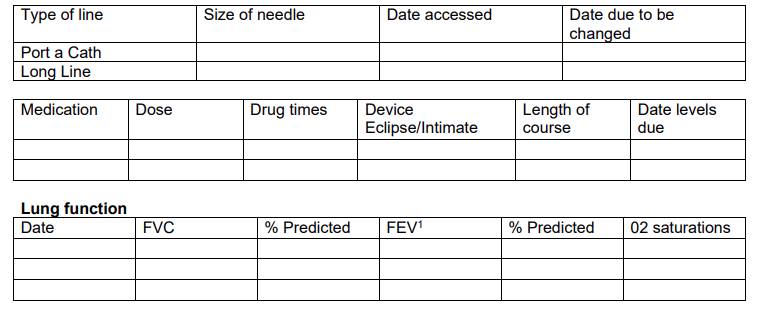
Checked and signed by:
For staff only: please place a copy of into the child’s notes.
How Lloyds home care delivery service operates:
You will be provided with all the equipment and medication you need to give IV therapy at home. This will be ordered by us and delivered to your home by Lloyd’s home care they will then contact you and arrange a delivery time. It may be necessary for Lloyd’s home care to make several deliveries to your home before you have everything that you need. They will try and make deliveries at times which are most convenient to you. If multiple deliveries are needed Lloyd’s will inform you of each of the delivery dates at the time of the first delivery.
If you have any questions or problems, such as missing equipment please contact Lloyd’s home care directly. All antibiotics supplied by Lloyd’s should be stored in the fridge provided and left at room temperature approximately 1 hour before administration (4 hours for an intimate device) or as advised by Lloyd’s home care. Lloyd’s home care operates 24 hours a day- every day except Sundays. They will need 48 hours’ notice before each delivery.
Your first delivery will include:
• Your medication and ancillaries (syringes, devices etc…)
• A fridge and fridge thermometer
• A letter detailing the dates of subsequent deliveries that you may be receiving.
When you have received your delivery you should check and place all the drugs in the fridge provided. Make sure you have enough drugs for each dose. Any problems please contact the number
provide. Deliveries will not be left on the door step. If you are unable to be home for your delivery, please call your Lloyd’s home care provider to make alternative arrangements.
LLOYD’S HOME CARE OUT OF HOURS ADVICE LINE 0845 7573 100.
Advice during office hours can be accessed via the customer service Team Mon – Fri 09.00 – 17.30pm on: 0845 602 3298. At times deliveries may need to be more frequent as not all antibiotics are stable in pre-filled syringes.
How to care for a PortaCath / long line
It is important to check the chest site of the Port a Cath / long line daily this is to ensure that the dressing remains secure and in place, and also that there is no infection. Signs of infection could
include your child having a temperature over 38 C, redness, swelling or pain around the site or if the site has any discharge (either pus or blood). If your child shows any sign of infection you must seek advice immediately as instructed by the Children’s Community Nursing Team.
When carrying out the daily check, ensure that the dressing is firmly attached to the chest. Should the dressing not be secure; place a further dressing on top of the existing one. Please check that the bungs are affixed tightly at the end of the line as this will reduce the risk of them falling off. It is very important that you ensure that the clamps remain closed. This will reduce the risk of blood loss should the bungs fall off or if the line becomes broken. Should the clamps be found to be open please contact your CF team or ward 4 (PAU) out of hours as the line will need flushing and stabilizing to keep it safely working and prevent the line blocking.
It is important to keep the dressing sight dry. At bath times the line can be taped to keep it out of the way, or you can even place the ends in a clean plastic bag (such as a sandwich bag), and then tape the bag. If the bung at the end of the line falls off, but the clamps are still securely in place this must be replaced with a new bung. Before attaching the replacement, wash hands thoroughly and clean the end of the central line for 20 seconds using a Sani-cloth wipe© and allow the area to dry for 20 seconds before attaching the replacement. Use three areas of the wipe on the end of the line and use pressure when cleaning.
The end of the line should not be touched with hands during the process. If the clamps are open and the bungs are off…… this is an emergency situation you MUST close the clamp, replace the bung and contact the CF team or ward 4 (PAU). Should the line become damaged or if there is a hole in the line, the line should be clamped between the chest and the break. If the clamps are not available, bend the line and hold with fingers.
Important Points to Remember
• If you have any questions regarding the care of a Hickman Line, please call the Children’s Community Nursing Team for advice and support.
• When drying hands once they have been washed, to reduce the risk of cross infection, use disposable towels such as kitchen roll.
• When possible, try to keep the port a Cath / long line under clothing. This will reduce the risk of the line being pulled out. Try to keep younger children from playing with the line.
• If your child is attending school with a Port a Cath, please inform school staff and also advise them what action is required in the event the line becomes broken or removed. You will be given an emergency kit by the community nurses and an explanation of how to use it.
Preparing the IV antibiotics:
1. Remove the device from the fridge
• Eclipse infuser remove from the fridge 1 hour before administration
• 4 -6 hours for the Intermate infuser or as advised from Lloyd’s home care.
2. Gather and prepare all the equipment that is needed and place next to your tray.
3. Find a clean work surface for getting the medication ready and use a tray.
4. Clean your tray with a Clinell© universal wipe starting on the inner surface and finishing on the outer surface. Allow tray to dry.
5. Wash your hands as instructed see page 14 of this document.
6. Make sure you check the following each time:
• Drug prescription sheet
• Name of medicine
• Dose
• Expiry date of drug
• Contents (if cloudy or contains sediment, DO NOT USE)
7. Open the packets and empty the pre filled syringes and Intermate/Eclipse infuser onto your clean tray. Place on tray and empty so key parts are not touched.
8. Remember to place syringes in order of giving i.e. Saline (3mls), antibiotic, saline (3mls), antibiotic, saline (4mls) Heparin (3mls) this is only required after the last dose.
9. Some intravenous drugs do not mix well together and crystals can form in the line. This is why it is important that saline is administered through the line before giving drugs, in-between each
antibiotic, and after completion of each dose.
10.Try to avoid distraction whilst preparing and giving the IV antibiotics e.g.
• Do not answer the phone or door
• Do not rush
• Avoid noisy TV
• Avoid friends/relatives talking to you
11. Home IVs are demanding so get plenty of rest in-between IVs, as tiredness can be a problem.
The Eclipse and Intermate infusers are devices which do not require electricity and are a non-gravity dependant delivery symptom of antibiotics. It is small and lightweight and can be hidden under clothing as no other equipment is needed. Unlike gravity systems the Intermate / Eclipse infusers frees the patient from equipment such as drip stands and pumps and the setting of flow rates, making the device simple to use. The Intermate / Eclipse infusers are pre-set in a pharmacy providing accurate dosages and pharmacy consistency which gives necessary safety when handling the infusion device.
The Intermate / Eclipse infusers reduce infection risks and reduce the number of complications that arise with infusion devices. The controlled rate prevents drugs being administered too quickly.
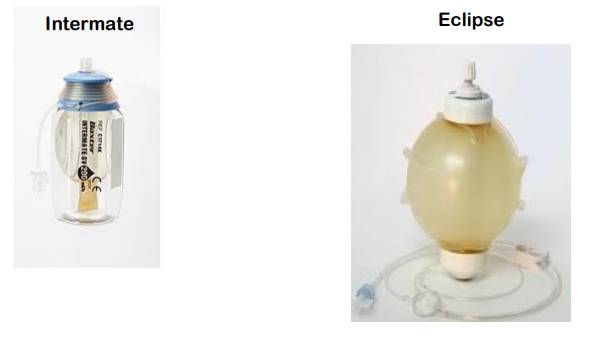
How to use the Eclipse and Intermate infuser devices
1. Check all the details on the label are correct:
• Name
• Drug
• Dose
• Expiry
Intermate Eclipse
2. Open 2 of the 10 ml (0.9 % sodium chloride flushes) pre filled syringe place them on the tray. Do not touch the ends. If touched, use new flush.
3. Open a Sani-cloth wipe and place in the tray.
4. Remove the cap from the end of the Eclipse tubing and open the white clamp. Allow the medication to drop out of the end of the line.
5. If using the Intermate infuser loosen protective cap on the end of the tubing open the clamp-this will allow the drug to enter the tubing this is called priming the line so that there is no air in the
tube, when the medication has dripped out of the end of the line close the clamp.
6. Once the air has been removed close the clamp again.
7. Place the Eclipse / Intermate infuser back into the tray.
8. Make sure that the PortaCath / long line end is exposed, then take of your gloves and wash and dry your hands thoroughly again following the hand washing guide.
9. Put on a clean pair of gloves.
10.Clean the bungs on the Port a Cath / long line thoroughly using three different areas of the wipe and use pressure when cleaning. The end of the line should not be touched with hands during the process. Allow to dry naturally for 30 seconds.
11.Continue to hold the bung with the Sani-cloth wipe© take one of the 10 ml pre filled syringes filled with 3 mls of 0.9 % sodium chloride, ensure there is no air in the syringe and insert onto the bung. Open the clamp and flush the line using a pulsating technique.
12.STOP IF:
• Your child feels any pain or discomfort
• You have any difficulty in injecting the line due to stiffness or resistance
• Redness around the site
• Leakage of the medication
13.If you notice either of the above please call the CF/Respiratory nurse or ward 4 (PAU) contact numbers are available on page 2
14.If there is no problem close the clamps remove the syringes and place to one side.
15.Connect the Eclipse / Intermate infuser using a quarter clockwise turn.
16. Open the clamp on the Port a Cath/long line and the Eclipse / Intermate infusers, the medication will now begin to infuse automatically this will take 30 to 60 minutes as indicated on the label, if it takes more than 15 minute longer then stated please get in touch with ward 4 (PAU) or your child’s CF/respiratory nurse as soon as possible.
17.Once the Eclipse infuser is complete and the balloon of the Eclipse is empty you should be able to feel the barrel in the centre of the Eclipse. There may be a small amount of liquid in the tubing and inner pump walls but this is fine.
18.You will know when the Intermate infuser is empty as the balloon will be touching all eight empty indicator bumps on two sides of the Intermate, the infuser works slowly so the balloon will appear
to be shrinking over the period of 30 to 60 minutes.
19.Wash and dry your hands again and put on a new pair of gloves
20.Close the clamp on the Port a Cath/Long line and disconnect the Eclipse / Intermate by untwisting the locked ends. Please do not touch the end of the bung.
21. Clean the ends of the bung with a Sani-cloth wipe, Attach the other pre filled 3 mls (0.9% sodium chloride) syringe to the bung and flush please remember to never use the same syringe twice.
22.Close the Port a Cath / long line and put to one side.
23.If a second antibiotic is to be given repeat numbers 10 to 20 again.
24.Heparin flush is only to be given after the last antibiotic doses of the day e.g. 22.00 attach the syringe filled with 3 mls of heparin to the bung and flush the line using pulsating technique. Never
use the same syringe twice.
25.Close the clamp and put the syringe to one side.
26.If using a long line bandage securely.
27.Dispose of waste syringes Eclipse / Intermate infusers in the sharps bin provided, all other materials can be placed in house hold rubbish.
Do not use the eclipse / Intermate device if:
• The expiry date has passed
• The name of the drug is incorrect
• The name on the label is not correct
• The balloon eclipse has burst, spilt or if there is any sign of leaking
• There is a spilt or break in the tubing
• The cap has been removed or missing
• The winged luer cap isn’t securely fastened on the Intermate infuser
If you notice any of the above please contact Lloyd’s home care.
Possible side effects whilst having IV therapy at home:
Allergic reactions to medications can happen at any time, even if you have had the medication many times before, it could be your child’s first dose or tenth dose. An allergic reaction may be mild or it may be anaphylaxis, which is more serious. Mild reactions can include itching of the feet or hands, rash, nausea or vomiting. If you think your child has any of these symptoms, stop giving the antibiotic immediately and call a member of the CF/Respiratory team as soon as possible for advice.
Anaphylaxis
This is an extremely dangerous and life threatening reaction that can sometimes occur. It is recognised by one/combination of the following signs, which will come on very quickly.
• Tightness of the chest, unable to breath as the airway is swollen.
• Severe rash (of any form).
• Swelling of lips, tongue, throat or eyes.
• Your child may also become confused or agitated.
If any of these symptoms occur stop giving the drug immediately and dial 999 for an ambulance. Tell the emergency services that your child is on home intravenous antibiotics and that they
are having a severe anaphylactic reaction.
Do not attempt to:
• Finish giving the drugs
• Wait even for a few minutes
• Take your child to hospital yourself
Diarrhoea and vomiting
• If your child becomes unwell with diarrhoea or vomiting while on intravenous antibiotics it is very important that you call the CF team for advice as soon as possible. You will then be advised on what steps to take and how best to care for your child.
• Having even a mild case of diarrhoea or vomiting can lead to children becoming dehydrated. This in turn can lead to the antibiotics levels becoming too high, which can cause serious
complications. So it is important that you contact the CF team as soon as possible.
Administering Aminoglycosides (Tobramycin)
Aminoglycosides are now given as a large once daily dose. They are infused slowly via an intimate/eclipse infuser device over a period of 30-60 minutes approximately. It is extremely important
that the once daily dose of Aminoglycosides is given every 24 hours and at the same time each day. This is known to work more efficiently against bacteria. If the antibiotic is given more frequently than every 24 hours, the risk of side effects is very high. To ensure the Aminoglycosides dose is correct levels are checked on day 2 one hour prior to the second dose and day 8 of the course.
Tobramycin may have the following side effects if blood levels are too high:
• It can affect the ears causing deafness, dizziness and tinnitus.
• Have an effect on kidney function and urine output for which the first sign is vomiting.
If you have given the Aminoglycoside earlier than the stated dose and/or your child vomits, you must contact your CF team or the ward immediately, so that arrangements can be made to bring your child to the ward to be seen and check blood levels.
Record home IV Antibiotics given
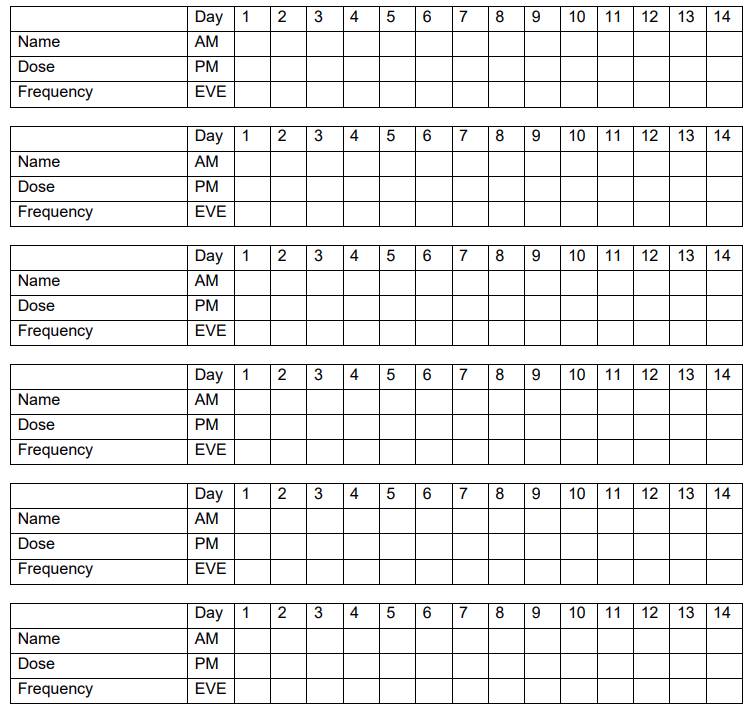
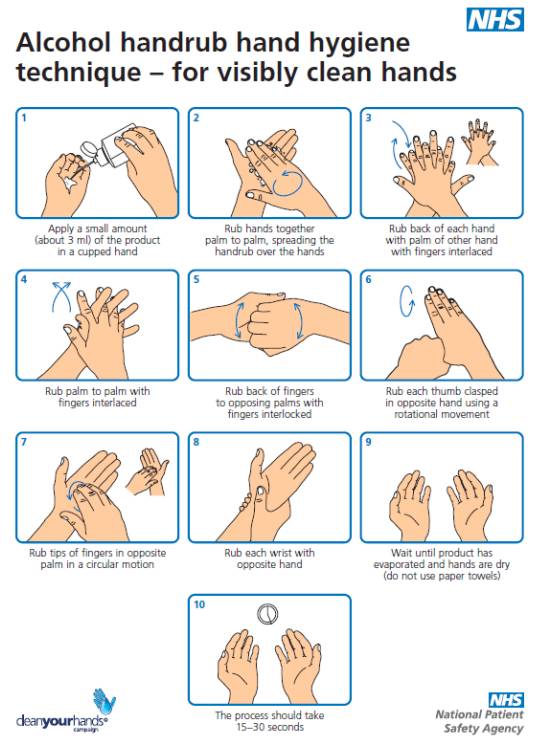
Competency Checklist – to remain in patients’ notes.
Qualified Nurses with an IV central line qualification will be able to use this document.
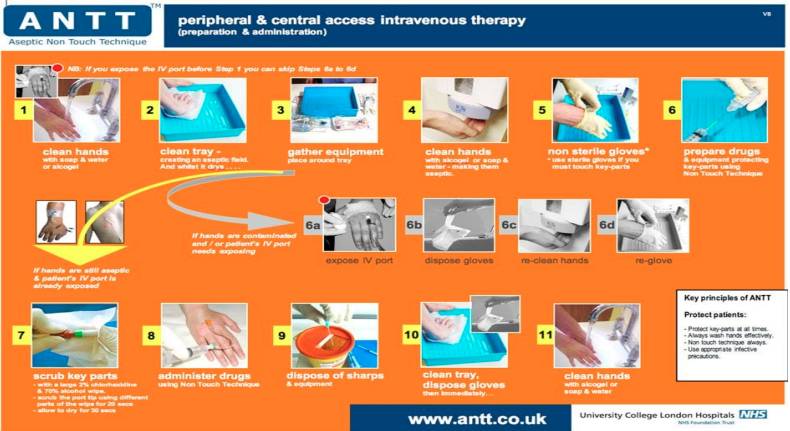
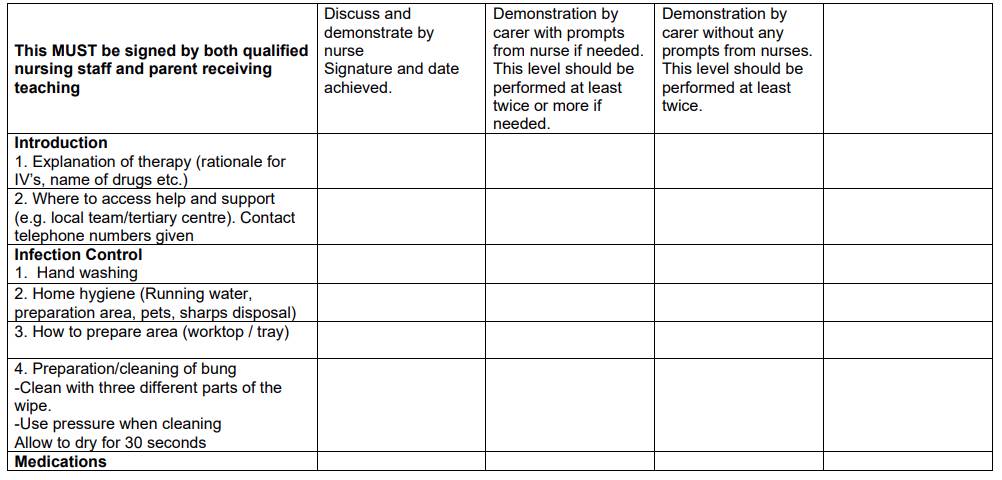
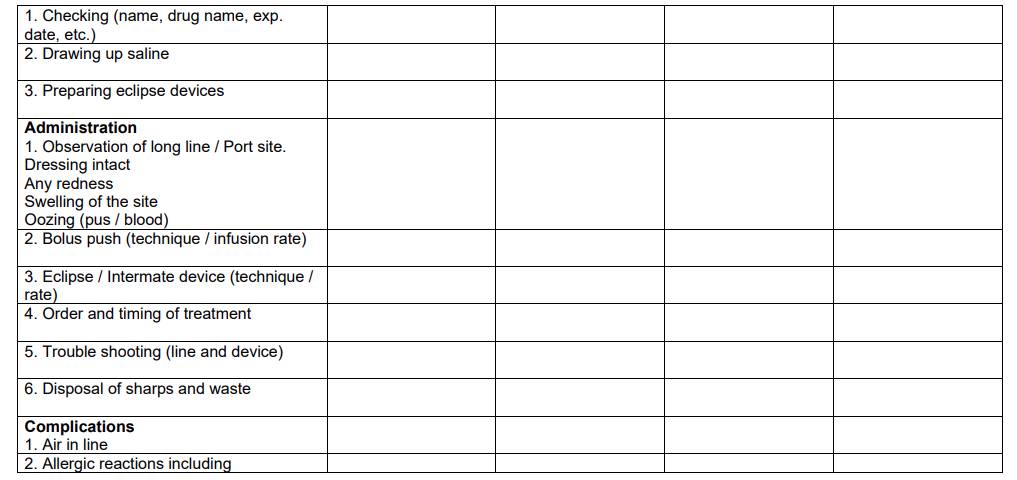

NB: Training can be stopped at any time if the parent/carer or nurse is not fully happy or confident. Parents/carers can stop training of home IV therapy at any time during the training and complete the course in hospital.
This section is to be competed and filed in the patients’ notes once training is completed. My child ………………………………………….. has been prescribed the following course of intravenous
antibiotics to be completed at home:
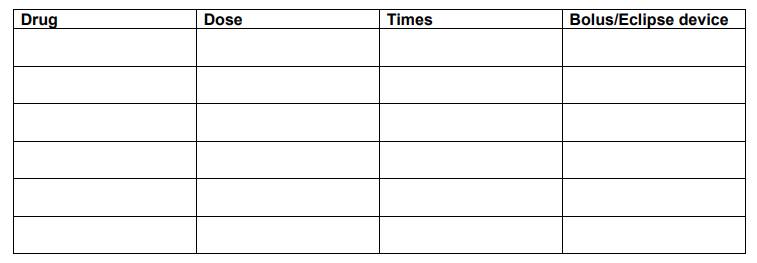
I have agreed to take on the role of administering intravenous antibiotics at home. I have been given the information and training in order to be competent and confident to do so. I understand that I have responsibility to ensure correct practice and the safety of my child. If I have any queries or do not understand any aspect of my child’s treatment, I will contact my CF team, Ward 4 (PAU), or on call.
Registrar for advice for which I have the contact details.
Date of last competency check* ________________________
Parents full name: ______________________________________________
Parents Signature: ______________________________________________
CF CNS/IV Nurse: ______________________________________________
Date: ________________________________________________________
* For staff only: if the date of the last competency check is more than a year ago, please re-assess the parent/carer using competency checklist.
Home IV’s ordered for next day delivery need to be ordered before 4pm the previous day
Investigations whilst on Home IVABs
• Spirometry should be recorded at least once mid-way through a course of home IV’s
• Aminoglycoside trough Levels must be organised before discharge.
• U & E’s must be organised before discharge if on Colistin
Checklist
Levels/ U&E’s booked
Reviewed by physio prior to leaving
Outpatients appt. booked for end of course
Arrangements made for removal of line/Port needle
